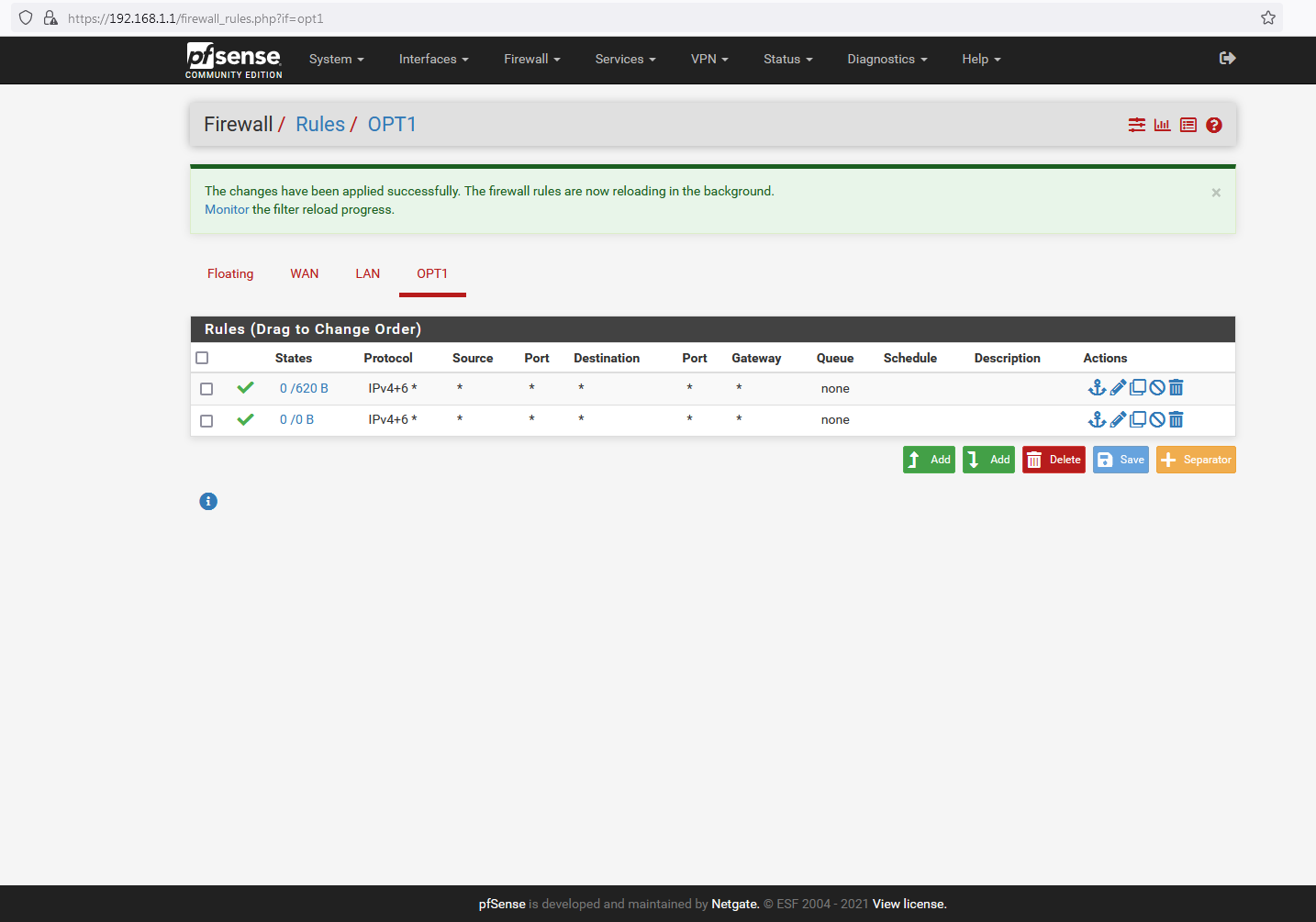Adding a Subnet to an Interface
-
@nogosubnet said in Adding a Subnet to an Interface:
it is no longer possible to connect to that interface from LAN - bge0 regardless of firewall rules to allow completely open access between the interfaces (including that of re0 - WAN, of course).
Nonsense.. Plan and simple.. Again... What IP space is on an interface has zero to do with access from another network attached to pfsense.
which also appears to be expected behaviour with pfSense.
Where are you getting such nonsense?
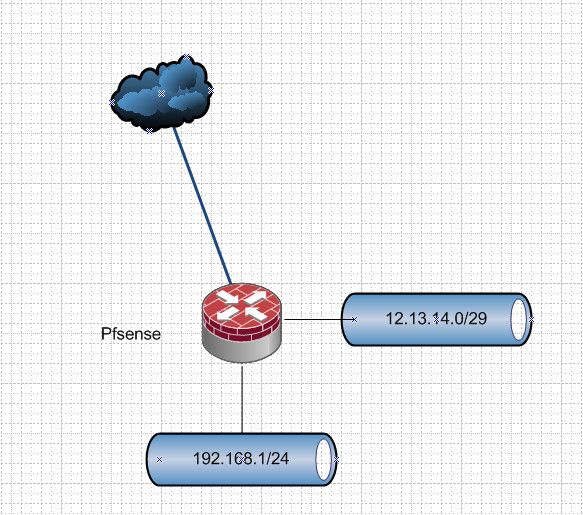
A device on either of these networks can talk to each other without issue.. Unless you have firewall rules blocking them, or policy route not allowing it.. Doesn't matter what the IP space is!
-
Normally I would agree, but that is not holding up on pfSense.
We can assume that rules on the router are not a factor because all of this is happening behind the router, and the router is functioning as a bridge only and we are dealing with private / local networks, so this argument (at this stage) is purely between re0, bge0, and bge1.
As for the rules in place in the webConfigurator (which is accessed via bge0 - LAN), I have rules between re0, bge0, and bge1 that allow each to talk openly to each other - IPv4 & IPv6, any protocol, any application; so how can the firewall possibly be getting in the way of things? - Provided that the BOGON and local net tick-boxes are not ticked, and therefore not a factor, the only way that the firewall could still be influencing things is if something is bugged, broken, or otherwise not working as intended.
On both bge0 and bge1 I have also taken the precaution of disabling the firewalls (as in those software firewalls that would normally be present on those systems), too, and, again, that made no difference (even following reboots, resets, etc.).
-
@nogosubnet said in Adding a Subnet to an Interface:
and the router is functioning as a bridge
Well there might where you have problem like I mentioned already..
If the router doesn't have an IP in the bridge, then no your not going to be able to talk to anything in the bridged network via routing.. Put an IP on the bridge interface so pfsense can route to it.
What exactly are you bridging - bge0 and bge1 to me just means its broadcom interfaces
-
@johnpoz the DSL line is connected to the Draytek router which, in turn, connects - and bridges the internet - to the pfSense setup, ie: rge0 - WAN (pfSense WAN, not the router WAN).
I would not be able to connect pfSense directly to the DSL line, as pfSense has no means of modulating and de-modulating the signal; however, I could look at adding the required subnet as a WAN IP alias on the router side and having that IP join the NAT IP Address Pool. - If I am understanding things correctly, that should advertise the subnet to all interfaces associated with rge0 - WAN and would mean that I could, potentially, access OPT - bge1 from LAN - bge0.
Internet connectivity works fine with the current setup, as it is, though: the issue is purely one of being able to get LAN - bge0 and OPT - bge1 talking to each other, so the latter can be managed via the former.
-
@nogosubnet dude I have no idea what your talking about.. Your dsl isp device being in bridge mode or pfsense setting up a bridge has zero to do with each other.
Do you have bridge setup in pfsense between wan and bge1?? And clients on bge1 network are pulling IPs via dhcp from your isp?
And that has zero to do with a specific public range being routed to you..
Please show this screen!

a bridged connection from a router
Is not a bridge in pfsense..
The routed subnet is /29 block of IPv4 addresses, so these are assigned via Static IPv4
What does that have to do with bridge in pfsense? You do not need to bridge in pfsense.. To be able to assign a public IP range to one of its interfaces.
-
This post is deleted! -
I think he is trolling you.
So many things dont make any sense from him. -
@marv21 No, not trolling, - I am actually trying to find a solution to the problem ...which is definitely not going to be with a group of people who are clearly incapable of reading several carefully-worded explanations and understanding that what they are dealing with is a basic network configuration (yes, I understand more about these issues than I let on).
Either way, though, and regardless of the above, I now know for definite that what I outlined here is not possible with pfSense (plus that there are zero workarounds) and will not be wasting any more time with a seemingly ignorant and hostile forum. I am also seriously glad that I did not waste several hundred pounds on a Netgate paperweight.
Incidentally, if you want answers from people it helps if you are capable of formulating a question specific enough to elicit the information you require ...and if you can avoid demanding the same information from people over and over again when the above could be used far more effectively. Also, should an image be required, it helps if the OP can be given an outline of the required format, labels, etc..
For anyone else wanting to know the conclusion of this post, and in summary: if you have (in this case) a personal computer, a webserver, and pfSense running on its own board (with a 2-port LAN card (bge0 for the personal computer and bge1 for the webserver)), bridged from a router (with DSL line to the router), and with a requirement to connect to the webserver from the personal computer, you will not be able to: in theory you should be able to route a connection request from the personal computer (LAN) to the webserver (OPT1) but, in practise, this is not possible with a pfSense configuration and there are no workarounds.
In my case there is also the issue of a routed subnet on the webserver side, which was variously added as a Routed IP Subnet on the router side and into the OPT1 configuration under the webConfigurator but, whether added to just one or both, neither configurations worked ...and even with this left out completely it was still not possible to establish a connection between the personal computer and the webserver.
Those who have replied insist on the problem being down to firewall rules, but this has been exhaustively ruled out (with the firewalls on both the webserver and personal computer disabled) and with fully open rules connecting all the interfaces; so, no, the indications are that this is is very definitely down to some serious limitations and possible coding issues in the pfSense software.
-
@nogosubnet said in Adding a Subnet to an Interface:
bridged from a router (with DSL line to the router
<rolleyes>
Your shooting yourself in the foot dude if your creating a bridge with pfsense.. And you can not even post a simple screenshot.
Why do you think you should bridge pfsense? Why??
You clearly can not state your issue correctly - or even post a specific screenshot when asked..
How do you think you could talk to something inside a bridge if you have no IP in this bridged network on pfsense?? But there is ZERO reason to bridge it.. ZERO!!
If you have your /29 bridged all the way to your webserver - then its not freaking routed.. Your PC is directly attached to your isp network through the bridge..
How would something with a public IP attached to some ISP via a bridge talk to a rfc1918 address?? If the network is actually routed to you - then route it to pfsense public IP that it gets through your bridged "Draytek" on its wan - rfc1918 connected to pfsense, and some other network connected to pfsense can route between each other just fine.
-
@nogosubnet said in Adding a Subnet to an Interface:
very definitely down to some serious limitations and possible coding issues in the pfSense software.
I understand your frustration but that’s incorrect. pfSense will route between its networks unless blocked by the firewall. So there’s something else going on but unfortunately we don’t know enough to help.
Re:bridging, I think you’re saying you bridged your ISP router so your pfSense has a public IP? That’s fine, but then saying your pfSense is bridged is confusing, since pfSense itself can be set up as a bridge.
-
@steveits yeah he seems to have bridge all the way through to his webserver?? Bridge on edge router, and another bridge on pfsense. Yet he states this /29 is routed to him..
An no if that is how he is setup he will not be able to talk to this rfc1918 hanging off pfsense. Just not possible without pfsense having an IP in the /29 on the bridge it can route via to the rfc1918 space
-
@johnpoz the bridge is from the router.
The router has to the first piece of hardware after the DSL line, correct?
...and the mainboard running pfSense has to go next in line, right?
...and all the guides indicate that the router (in this case a Draytek Vigor 2860) has to be in bridged mode (which makes sense because, otherwise, the pfSense setup would just be another device alongside the PC and the webserver communicating with the internet but otherwise serving no purpose); hence the router is working in bridged mode in order to allow pfSense to control the internet traffic to and from the PC and the webserver (not to mention any traffic between the PC and the webserver).
I am certain that I am not wrong in this, and I can confirm that I have not added any bridge configuration under the webConfigurator. - If that is going to be required, then fair enough, but, as it stands at the moment, I have not configured any bridge and can access the internet from the PC, via pfSense, with no problem.
I will reset pfSense and submit a screenshot of the dashboard, which will hopefully clarify some things.
-
@nogosubnet said in Adding a Subnet to an Interface:
I have not added any bridge configuration under the webConfigurator.
Then pfsense would HAVE TO HAVE an IP in your /29
If so then you you could route between your rfc1918 on lan and the network on your opt1 network.. As long as device in lan is using pfsense lan IP as its gateway, and device in your /29 is using pfsense IP on opt as its gateway.
-
@johnpoz How do I route from an RFC? - I thought that they were simply that, - not interfaces. The LAN uses the pfSense WAN by default (I am using the internet connection from that at the moment).
I do not have private networks blocked (if that is a potential issue - and the source of the RFC note), so I guess that all I need now is a pfSense bridge between WAN and OPT1?
-
@nogosubnet said in Adding a Subnet to an Interface:
he LAN uses the pfSense WAN by default (I am using the internet
What??
Here expanded drawing.
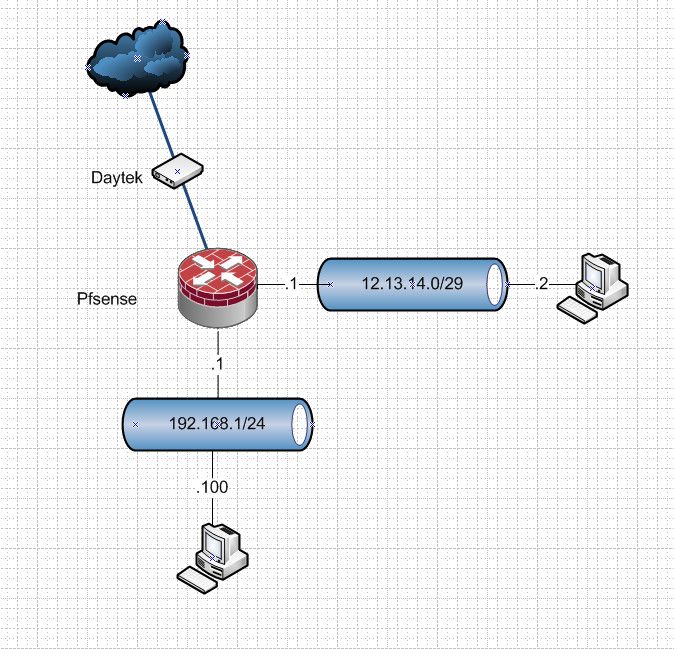
I have a device on my rfc1918 network on lan.. This device would use pfsense lan IP of 192.168.1.1 as it gateway. Now my routed public network. In my example 12.13.14.0/29 where pfsense IP in this network is 12.13.14.1 and your webserver is 12.13.14.2 - it would be using pfsense 12.13.14.1 as its gateway.
if your webserver wants to go to 192.168.1.100, it would send that traffic to pfsense. Pfsense would say oh yeah I am connected to this 192.168.1/24 network - let me send that on. As long as the firewall rules on opt allow it.
Do you have some gateway hard coded in your opt1 rules? Please post your opt1 rules, and your lan rules. There should be no gateway setup in the firewall rules - or your policy routing. Which if you are, then there would need to be a rule above this policy route that allows your traffic.
-
@johnpoz OK, - I will post those and confirm that I have created no firewall rules at all at the moment, except the auto-generated BOGON rules.
WAN:
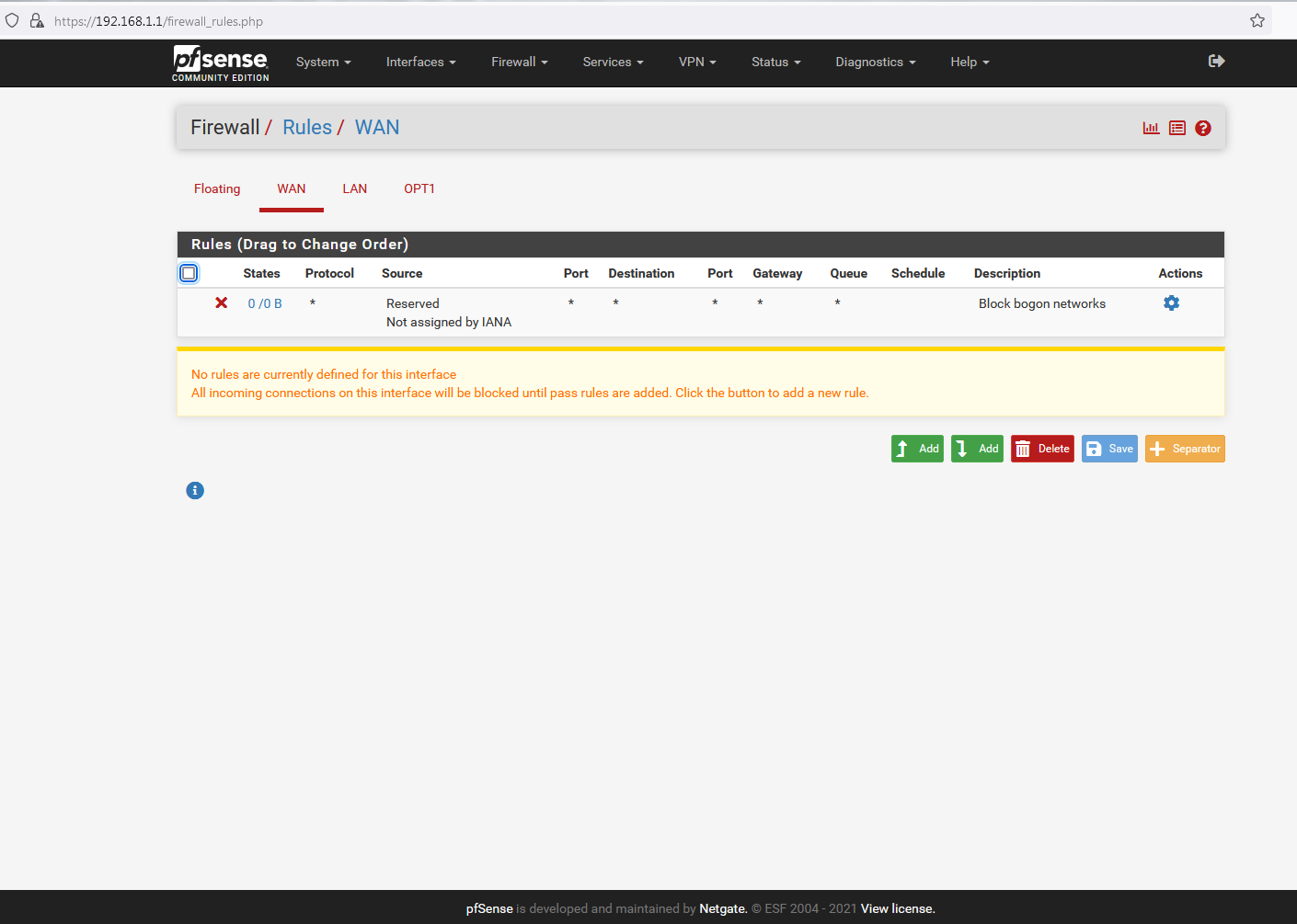
LAN:
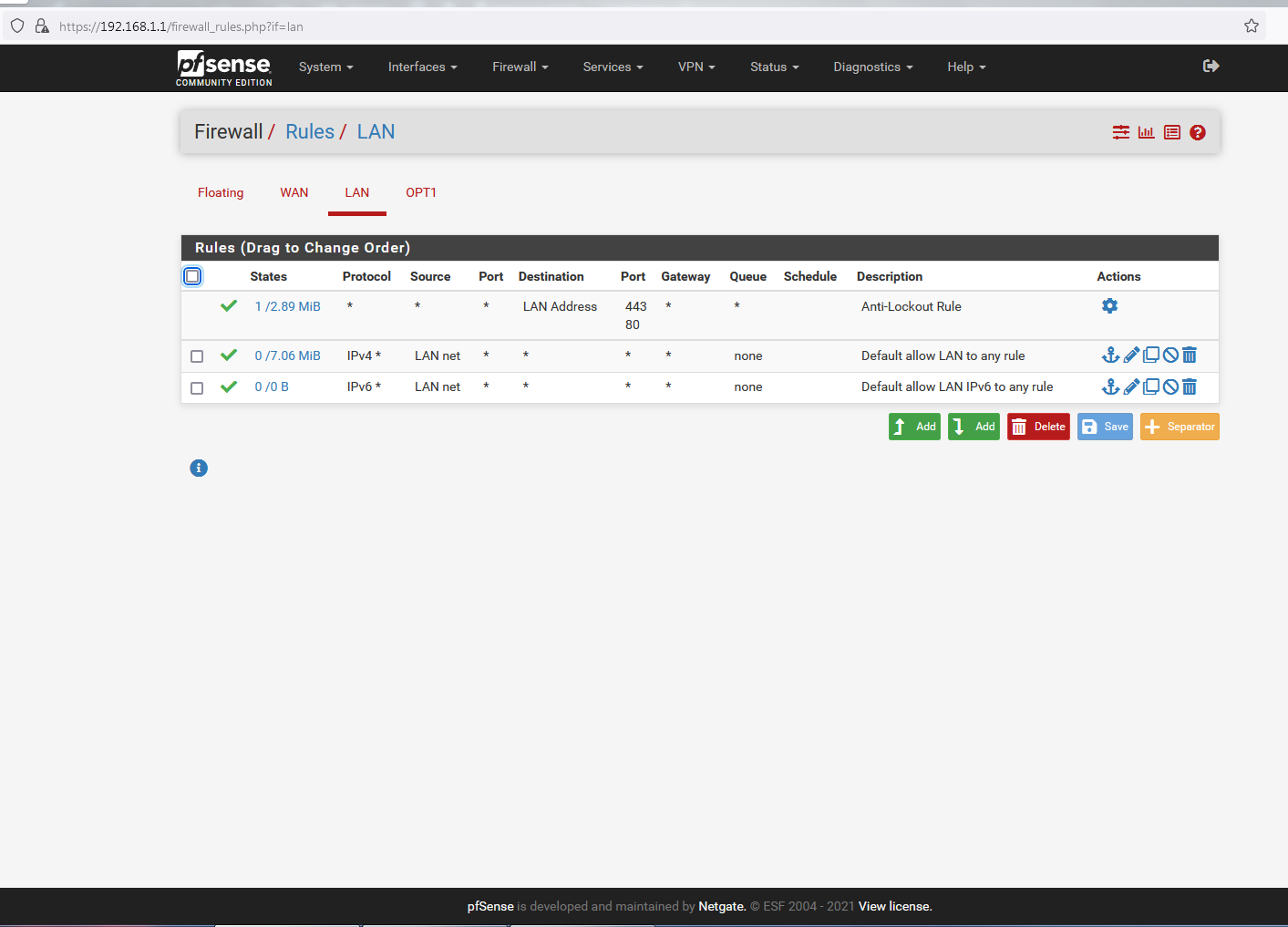
OPT1:
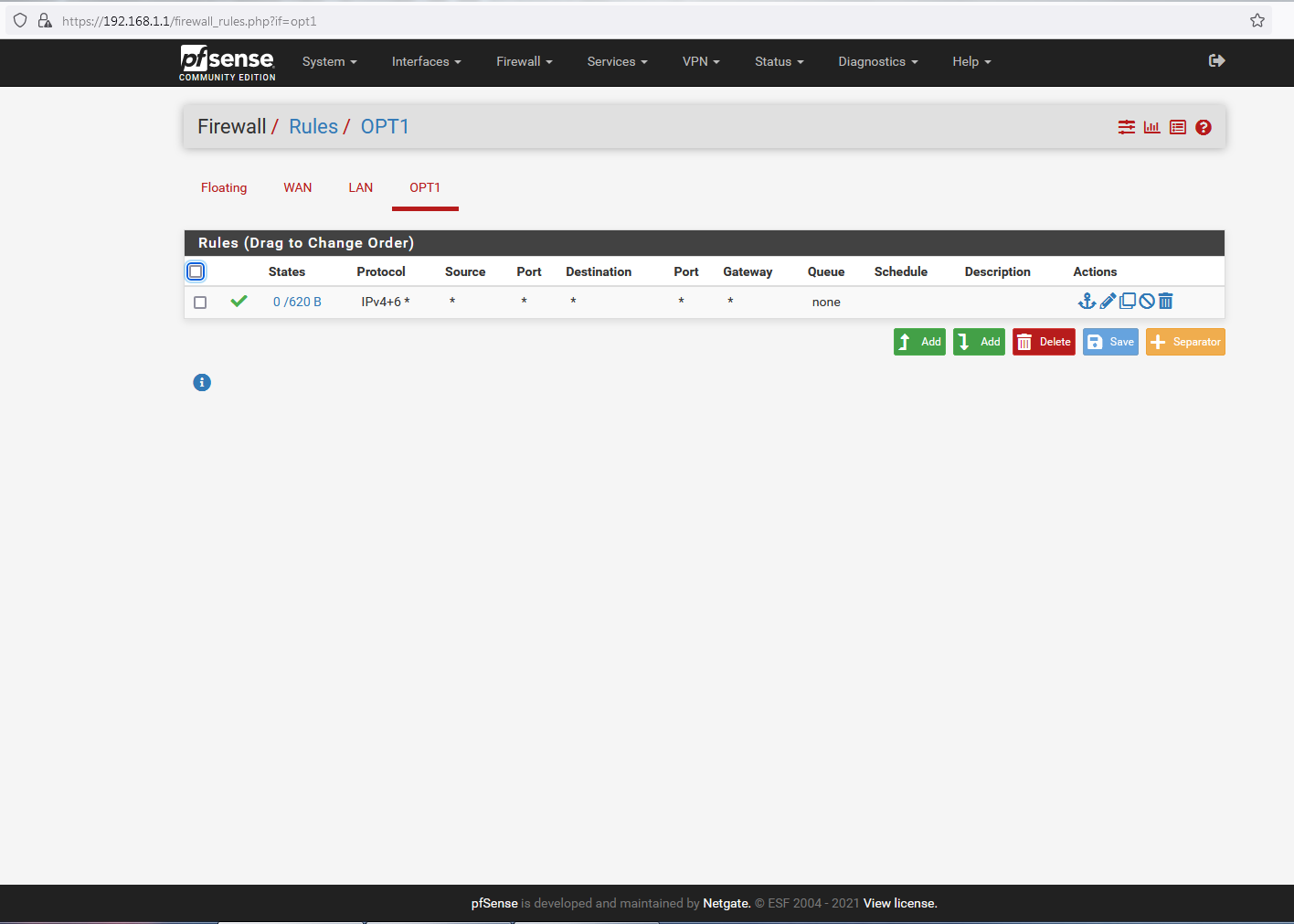
-
@nogosubnet bogon would only go on WAN interface..
Lan rules would default to any any, and opt1 interface would have NO rules by default. You would have to create 1, say a any any rule to get started with.
-
@nogosubnet why would you have bogon on your OPT? Bogon would include rfc1918.. Please post Screenshot of rules.. not some ascii art..
edit:
Out of the box wan would have block rfc1918 and bogon.
Lan would have antilock and any any rule
opt1 would have nothing - you have to create rules on new interfaces. So create an any rule - and there you go you can route between lan and your public network on opt1When you route public space on pfsense lan side network, you also want to make sure your not natting it.
https://docs.netgate.com/pfsense/en/latest/recipes/route-public-ip-addresses.html
-
There you go.. What about your nat rules? If you do not edit those your public space network would be natted to your pfsense wan IP.
But with those rules - you would be able to talk from your webserver on your opt network to your lan network. As long as you didn't put something in floating blocking it.
-
@johnpoz - thanks, - just tested, but not working.
